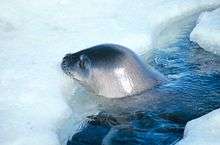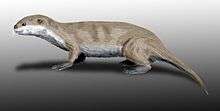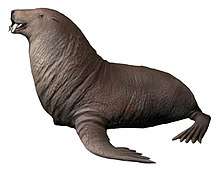Weddell seal
The Weddell seal (Leptonychotes weddellii) is a relatively large and abundant true seal (family: Phocidae) with a circumpolar distribution surrounding Antarctica. The Weddell seal was discovered and named in the 1820s during expeditions led by British sealing captain James Weddell to the area of the Southern Ocean now known as the Weddell Sea.[3] The life history of this species is well documented since it occupies fast ice environments close to the Antarctic continent and often adjacent to Antarctic bases.[4]
| Weddell seal[1] | |
|---|---|
%E2%80%93Weddell_seal_(Leptonychotes_weddellii)_03.jpg) | |
| At the D'Hainaut Island, Mikkelsen Harbour, Trinity Island | |
| Scientific classification | |
| Kingdom: | Animalia |
| Phylum: | Chordata |
| Class: | Mammalia |
| Order: | Carnivora |
| Clade: | Pinnipediformes |
| Clade: | Pinnipedia |
| Family: | Phocidae |
| Genus: | Leptonychotes Gill, 1872 |
| Species: | L. weddellii |
| Binomial name | |
| Leptonychotes weddellii (Lesson, 1826) | |
| Weddell seal range
Water
Ice
Range | |
Description
Weddell seals measure about 2.5–3.5 m (8 ft 2 in–11 ft 6 in) long and weigh 400–600 kg (880–1,320 lb).[5][6] They are amongst the largest seals, with a rather bulky body and short fore flippers relative to their body length.[7] Males weigh less than females, usually about 500 kg (1,100 lb) or less. Male and female Weddell seals are generally about the same length, though females can be slightly larger.[8] However, the male seal tends to have a thicker neck and a broader head and muzzle than the female.[9] A molecular genetic based technique has been established to confirm the sex of individuals in the laboratory.[10] The Weddell seal face has been compared to that of a cat due to a short mouth line and similarities in the structure of the nose and whiskers.[9]
1.jpg)
The Weddell seal grows a thin fur coat around its whole body except for small areas around the flippers. The colour and pattern of the coat varies, often fading to a duller colour as the seal ages.[8] This coat moults around the beginning of summer.[9] Adults show a counter-shaded coloration that varies from bluish-black to dark gray dorsally and to light gray/silver ventrally. Coats may change to shades of brown before the annual molt.[9] Adult males usually bear scars, most of them around the genital region. Weddell seal pups are born with a lanugo of similar coloration and they moult after 3–4 weeks; later, they turn a darker color similar to that of adults. The pups are around half the length of their mother at birth, and weigh 25–30 kg (55–66 lb). They gain around 2 kg (4.4 lb) a day, and by 6–7 weeks old they can weigh around 100 kg (220 lb).[8]
Behavior
Movements

Weddell seals are commonly found on fast ice, or ice fastened to land, and gather in small groups around cracks and holes within the ice.[11] In the winter, they stay in the water to avoid blizzards, with only their heads poking through breathing holes in the ice.[8] These seals are often observed lying on their sides when on land. Weddell seals are non-migratory phocids that move regionally to follow the distribution of breathing holes and exit cracks within the ice changes between seasons.[12] The species is primarily restricted to Antarctic waters: physical factors, such as glacial movement and tidal action, may increase fluctuations in distributions.
Foraging
Weddell seals dive to forage for food, maintain breathing holes in fast ice, and explore to find more ice holes.[13] They have been observed to dive as deep as 600 m for up to an hour.[12] These seals exhibit a diel dive pattern, diving deeper and longer during the day than at night.[14] After dropping away from a breathing hole in the ice, the seals become negatively buoyant in the first 30 to 50 m, allowing them to dive with little effort.[15] Weddell seals are top predators in the Antarctic. They eat an array of fish, bottom-feeding prawns, cephalopods and crustaceans.[16] A sedentary adult eats around 10 kg (22 lb) a day, while an active adult eats over 50 kg (110 lb) a day.[8] Antarctic cod and silverfish constitute the majority of their diet. Cephalopods are common prey, and crustacean remains are sometimes found in Weddell seal scat, but at much lower rates than other prey species. They are opportunistic feeders that hunt in different parts of the water column depending on prey availability. Weddell seals hunt in both pelagic and benthic-demersal habitats.[17] Although seabirds are not usually part of their diet, there have been several sightings of them chasing and killing penguins in the wild. Other Antarctic phocids are known to be seabird predators, resulting in implications that penguin hunting is a learned behavior. There are recordings of four different penguin species being attacked by Weddell seals: gentoo penguins, an emperor penguin, an Adélie penguin, and a chinstrap penguin. It has not been confirmed, however, if the penguins were consumed after being killed.[18] Scientists believe Weddell seals rely mainly on eyesight to hunt for food when there is light. However, during the Antarctic winter darkness, when there is no light under the ice where the seals forage, they rely on other senses, primarily the sense of touch from their vibrissae or whiskers, which are not just hairs, but very complicated sense organs with more than 500 nerve endings that attach to the animal's snout. The hairs allow the seals to detect the wake of swimming fish and use that to capture prey.[19] Weddell seals have no natural predators when on fast ice. At sea or on pack ice, they are prey for killer whales and leopard seals, which prey primarily on juveniles and pups.[8]
Breeding
Weddell seals return to fast ice colonies during the spring for birthing and breeding.[20] Weddell seal populations will often return to the same breeding sites over consecutive breeding seasons.[21] Depending on the latitude it inhabits, this marine mammal gives birth from early September through November, with those living at lower latitudes giving birth earlier.[12] Weddell seals usually give birth to one pup per year,[12] however the Weddell seal is one of the only species of seals that can give birth to twin pups.[3] Birth of the pup only takes around one to four minutes. Newborn pups weigh about 25–30 kg and grow to two times their weight within their first week of life.[12] The pups take their first swim around one to two weeks of age.[12] During the first two weeks mother Weddell seals distinguish their pups through olfactory smells, specialized vocalizations, and stay in the same spatial area.[22] After six to seven weeks, pups are weaned and begin to hunt independently.[8]
_44.jpg)

Weddell seals show moderate polygyny and genetic analyses of mating success have suggested how factors such as size, diving ability, site-specific experience enhances success in male Weddell seals.[23] Additionally, fast ice breeding grounds causes females to cluster in large aggregations, making it easier for males to take control over his own harem.[21] The mating season occurs during austral spring between late November and December after pups are weaned and females begin ovulating.[12] During the mating season, Weddell seals make noises loud enough to be felt through the ice.[3] Males defend underwater territories during the breeding season and have been observed to fight.[24] Copulation has only been observed to occur under water, where the female submits to the male as he approaches her dorsal side. The female is often bitten on the neck by her partner if she tries to escape or terminate copulation.[25] The seals are normally around six to eight years old when they first breed, but this can be much earlier for some females.[9] Weddell seals undergo delayed implantation. The embryo is not embedded into the uterus until the beginning of austral summer, between mid-January and mid-February, allowing for birth under more favorable environmental conditions.[12] Juvenile Weddell seals (0–2 years old) have a high mortality probability, whereas no differences can be found between the mortality rate of animals older than 2 years and that of adults (Hastings et al., 1999). Maximum lifespan of the species is estimated at least 25 years.
Vocalization
Male and female Weddell seals communicate through a variety of sounds, specifically males sometimes use “trills” to communicate. Weddell seals are also able to communicate to each other through different mediums. Weddell seals on ice are able to hear the calls of Weddell seals in the water as long as noise level on land is low and they are in close proximity of one another. Sound waves can be transmitted either through the ice itself or from water to breathing holes where female Weddell seals are usually breeding.[26] There have been recordings of Weddell seal vocalizations that are described as songs. Their songs consist of repetitive sequences of the same vocal elements, and they only vary slightly over time. Individual Weddell seals can each produce their own unique song, but singing behavior is not common when observed.[27] Vocalizations are also important in mother-pup Weddell seal interactions. Mother Weddell seals use vocalizations to call their pups from further distances when smell can no longer be used efficiently (Opzeeland et al., 2011). Pups also use higher, more urgent vocalizations when hungry to alert their mothers to feed.[28]
Taxonomy
Rice [29] noted that the scientific name was misspelled in the past as L. weddelli and this synonym is no longer accepted, although it is still found commonly in the scientific literature prior to 1988.
Weddell seals can be confused with other two phocids that share the same range: Ross seal (Ommatophoca rossii) and crabeater seal (Lobodon carcinophagus).
Population status
Weddell seals are the second most abundant species of Antarctic phocid, after the crabeater seal. The best available estimate suggests that the species greatly exceeds 1,000,000 individuals, which was considered the upper limit from previous estimations [30] although there is large uncertainty in these figures. Because of their widespread distribution, population assessments are difficult and expensive to conduct, and are therefore infrequently undertaken.
Threats
During the early periods of Antarctic exploration, Weddell seals suffered dramatic declines as they were hunted for food and oil. Populations have since recovered after the elimination of commercial sealing in the 1980s.[2]
However, the effects of global climate change on Antarctic seals are still to be fully determined. Research estimates seal populations may decline as the availability of their habitat is extremely temperature sensitive thus making them potentially vulnerable.[31] Climate changes affecting the duration and the extent of the sea ice and nutrients availability could potentially reduce pups’ survival and may have important implications for population growth rates.[32] The fact that some populations breed on land (e.g., at South Georgia), could demonstrate an ability in the species to colonize different environments, although the extent of such plasticity is uncertain.[2]
In the past, the establishment of Antarctic research bases has caused a measure of disturbance to these seals. In January 1998 the Environmental Protection Protocol to the Antarctic Treaty was ratified, implementing environmental measures such as the banning of mining and oil drilling in Antarctica for at least 50 years, along with the banning of refuse disposal and the use of pesticides in the region.[2] However, the disturbance effects of the increasing seasonal tourism in the Antarctic and Sub-Antarctic on Weddell seal behavior, distribution, and foraging are still unknown.
Currently there are no reports of significant fisheries interactions. Although, the development of new fisheries in Antarctic waters, particularly one targeting the Antarctic toothfish, could have an impact on Weddell seal nutrition, and potential operational interactions should be considered in the management plans.
Conservation status
The Weddell seal is protected by the Antarctic Treaty and the Convention for the Conservation of Antarctic Seals (CCAS). It is classified as being of "least concern" by the IUCN.[2] This species is not listed by CITES.
See also
References
- Wozencraft, W.C. (2005). "Order Carnivora". In Wilson, D.E.; Reeder, D.M (eds.). Mammal Species of the World: A Taxonomic and Geographic Reference (3rd ed.). Johns Hopkins University Press. ISBN 978-0-8018-8221-0. OCLC 62265494.
- Hückstädt, L. (2015). "Leptonychotes weddellii". IUCN Red List of Threatened Species. 2015: e.T11696A45226713. Retrieved 14 February 2020.CS1 maint: ref=harv (link)
- Todd B (2002). Seals and sea lions. New Zealand: Reed Publishing Ltd.
- Siniff D (1991). "An overview of the ecology of Antarctic seals". American Zoologist. 31 (1): 143–149. doi:10.1093/icb/31.1.143.
- Kindersley, Dorling (2001). Animal (2005 ed.). New York City: DK Publishing. ISBN 978-0-7894-7764-4.
- Ballesta, Laurent (July 2017). "The Beauty Below The Ice". National Geographic. 232 (1). National Geographic Society. p. 67. Retrieved November 17, 2017 – via nationalgeographic.com.
- Hückstädt LA (2018). "Weddell Seal: Leptonychotes weddellii". Encyclopedia of Marine Mammals: 1048–1051. doi:10.1016/B978-0-12-804327-1.00267-3.
- Westerskov, Kim (1997). Seals of the blizzard: The Weddell Seals of Antarctica. Australia: Omnibus Books. ISBN 9781862912212.
- Shirihai H (2006). Whales, dolphins, and seals: A field guide to the marine mammals of the world. A. and C. Black.
- Curtis C, Stewart BS, Karl SA (2007). "Sexing pinnipeds with ZFX and ZFY loci". Journal of Heredity. 98 (3): 286–290. doi:10.1093/jhered/esm023. PMID 17548861.
- Smith MS (1965). "Seasonal movements of the Weddell seal in McMurdo Sound, Antarctica". The Journal of Wildlife Management. 29 (3): 464–470. doi:10.2307/3798043. JSTOR 3798043.
- Stirling I (1969). "Ecology of the Weddell seal in McMurdo Sound, Antarctica". Ecology. 50 (4): 573–586. doi:10.2307/1936247. JSTOR 1936247.
- Davis RW, Fuiman LA, Williams TM, Horning M, Hagey W (2003). "Classification of Weddell seal dives based on 3 dimensional movements and video-recorded observations". Marine Ecology Progress Series. 264: 109–122. Bibcode:2003MEPS..264..109D. doi:10.3354/meps264109.
- Kooyman GL (1975). "A comparison between day and night diving in the Weddell seal". Journal of Mammalogy. 56 (3): 563–574. doi:10.2307/1379469. JSTOR 1379469.
- Mitani Y, Watanabe Y, Sato K, Cameron MF, Naito Y (2004). "3D diving behavior of Weddell seals with respect to prey accessibility and abundance". Marine Ecology Progress Series. 281: 563–574. Bibcode:2004MEPS..281..275M. doi:10.3354/meps281275.
- Riedman M (1990). The pinnipeds: seals, sea lions, and walruses. USA: University of California Press.
- Daneri GA, Negri A, Coria NR, Negrete J, Libertelli MM, Corbalán A (2018). "Fish prey of Weddell seals, Leptonychotes weddellii, at Hope Bay, Antarctic Peninsula, during the late summer". Polar Biology. 41 (5): 1027–1031. doi:10.1007/s00300-018-2255-z.
- Bombosch A, Solovyev B (2017). "Weddell seal (Leptonychotes weddellii) killing gentoo penguin (Pygoscelis papua) at Neko Harbour, Antarctic Peninsula". Polar Biology. 40 (9): 1899–1902. doi:10.1007/s00300-016-2070-3.
- Peter Rejcek (August 27, 2010). "Scientists track seal predation behavior through the dark of Antarctica". The Antarctic Sun. Retrieved May 30, 2012.
- Schreer JF, Testa JW (1996). "Classification of Weddell seal diving behavior". Mammal Science. 12 (2): 227–250. doi:10.1111/j.1748-7692.1996.tb00573.x.
- Zappes IA, Fabiani A, Sbordoni V, Rakaj A, Palozzi R, Allegrucci G (2017). "New data on Weddell seal (Leptonychotes weddellii) colonies: A genetic analysis of a top predator from the Ross Sea, Antarctica". PLOS ONE. 12 (8): e0182922. Bibcode:2017PLoSO..1282922Z. doi:10.1371/journal.pone.0182922. PMC 5552091. PMID 28796829.
- Opzeeland IC, Parijs SM, Frickenhaus S, Kreiss CM, Boebel O (2012). "Individual variation in pup vocalizations and absence of behavioral signs of maternal vocal recognition in Weddell seals (Leptonychotes weddellii)". Marine Mammal Science. 28 (2): 158–172. doi:10.1111/j.1748-7692.2011.00505.x.
- Harcourt RG, Kingston JJ, Cameron MF, Waas JR, Hindell MA (2007). "Paternity analysis shows experience, not age, enhances mating success in an aquatically mating pinniped, the Weddell seal (Leptonychotes weddellii)". Behavioral Ecology and Sociobiology. 61 (4): 643–652. doi:10.1007/s00265-006-0294-x.
- Thomas JA, DeMaster DP (1983). "Diel haul-out patterns of Weddell seal (Leptonychotes weddelli) females and their pups". Canadian Journal of Zoology. 61 (9): 2084–2086. doi:10.1139/z83-273.
- Cline DR, Siniff DB, Erickson AW (1971). "Underwater copulation of the Weddell seal". Journal of Mammalogy. 52 (1): 216–218. doi:10.2307/1378453. JSTOR 1378453.
- Terhune, John M. (2017-04-13). "Through-ice communication by Weddell seals (Leptonychotes weddellii) is possible". Polar Biology. 40 (10): 2133–2136. doi:10.1007/s00300-017-2124-1. ISSN 0722-4060.
- Green, K.; Burton, H. R. (January 1988). "Do Weddell seals sing?". Polar Biology. 8 (3): 165–166. doi:10.1007/bf00443448. ISSN 0722-4060.
- Collins, Kym T.; McGreevy, Paul D.; Wheatley, Kathryn E.; Harcourt, Robert G. (July 2011). "The influence of behavioural context on Weddell seal (Leptonychotes weddellii) airborne mother-pup vocalisation". Behavioural Processes. 87 (3): 286–290. doi:10.1016/j.beproc.2011.06.005. ISSN 0376-6357. PMID 21718762.
- Rice DW (1998). Marine Mammals of the World: Systematics and Distribution. 4. Lawrence, Kansas: Society for Marine Mammalogy.
- Southwell C, Bengston J, Bester M, Blix AS, Bornemann H, Boveng P, Plötz J (2012). "A review of data on abundance, trends in abundance, habitat use and diet of ice-breeding seals in the Southern Ocean". CCAMLR Science. 19: 49–74.
- Evans, PG, Pierce GJ, Panigada S (2010). "Climate change and marine mammals". Journal of the Marine Biological Association of the United Kingdom. 90 (8): 1483–1487. doi:10.1017/S0025315410001815.
- Garrott RA, Rotella JJ, Siniff DB, Parkinson CL, Stauffer GE (2012). "Environmental variation and cohort effects in an Antarctic predator". Oikos. 121 (7): 1027–1040. doi:10.1111/j.1600-0706.2011.19673.x. hdl:2060/20110022991.
External links
| Wikimedia Commons has media related to Leptonychotes weddellii. |
| Wikispecies has information related to Leptonychotes weddellii |


